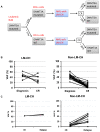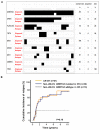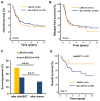Acute myeloid leukemia derived from lympho-myeloid clonal hematopoiesis
- PMID: 27881874
- PMCID: PMC7610466
- DOI: 10.1038/leu.2016.345
Acute myeloid leukemia derived from lympho-myeloid clonal hematopoiesis
Abstract
We studied acute myeloid leukemia (AML) patients with lympho-myeloid clonal hematopoiesis (LM-CH), defined by the presence of DNA methyltransferase 3A (DNMT3A) mutations in both the myeloid and lymphoid T-cell compartment. Diagnostic, complete remission (CR) and relapse samples were sequenced for 34 leukemia-related genes in 171 DNMT3A mutated adult AML patients. AML with LM-CH was found in 40 patients (23%) and was associated with clonal hematopoiesis of indeterminate potential years before AML, older age, secondary AML and more frequent MDS-type co-mutations (TET2, RUNX1 and EZH2). In 82% of AML patients with LM-CH, the preleukemic clone was refractory to chemotherapy and was the founding clone for relapse. Both LM-CH and non-LM-CH MRD-positive AML patients who achieved CR had a high risk of relapse after 10 years (75% and 75%, respectively) compared with patients without clonal hematopoiesis in CR with negative MRD (27% relapse rate). Long-term survival of patients with LM-CH was only seen after allogeneic hematopoietic stem cell transplantation (HSCT). We define AML patients with LM-CH as a distinct high-risk group of AML patients that can be identified at diagnosis through mutation analysis in T cells and should be considered for HSCT.
Conflict of interest statement
The authors have no potential conflicts of interest.
Figures





References
MeSH terms
Substances
Grants and funding
LinkOut - more resources
Full Text Sources
Other Literature Sources
Research Materials
Miscellaneous

